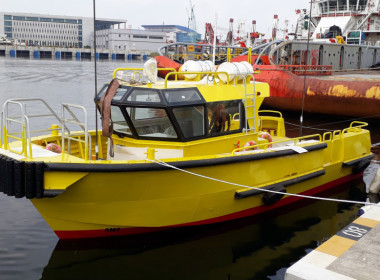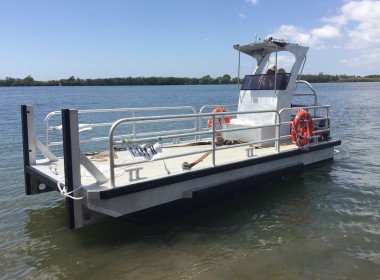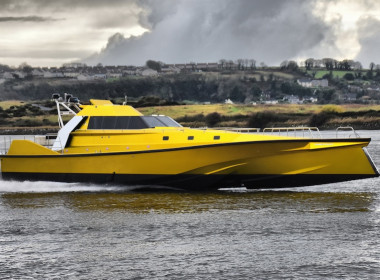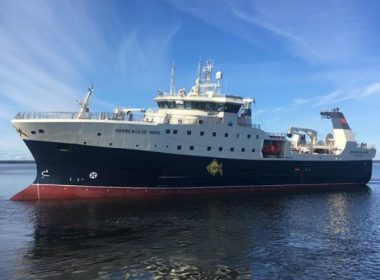AWARDS 2022 | Best OSV – Medium WFSV – Manor Victor & Manor Vulcan – BMT & Strategic Marine

Best OSV – Medium WFSV – Manor Victor & Manor Vulcan – BMT & Strategic Marine
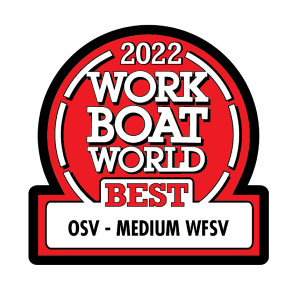
A pair of economical, safe, comfortable, and effective aluminium catamarans. They are very thoughtfully designed and have been very carefully constructed so as to represent all the latest developments of the WFSV sector.
“The boats have been specifically designed for enhanced transfer and payload carrying capability whilst offering a state of the art work environment for crews and technicians,” Martin Bissuel, Head of Sales Commercial Maritime at BMT, told Baird Maritime. “The propulsion setup has been optimised to increase the bollard pull to 15 tonnes, which enhances the technician transfer capability in a broader range of conditions for a higher utilisation of the vessels.
Bissuel said that in order to increase the internal space of the vessel, the superstructure is asymmetrical, and the interior has been fitted out for a superior finish, providing an improved work environment for the occupants.
“Both vessels also feature the latest generation of our patented active fender technology that dampens contact when pushing against the turbine tower. This reduces impact loads for turbine structures and allows the vessels to engage at higher sea states, improving safety during personnel transfers.”
“These two vessels mark the first hybrid ready 27-metre crewboats launched by our company,” added Strategic Marine. “The design offers operators a versatile platform that builds on more than a decade of experience in collaboration with our partners in developing and building similar vessels for offshore wind operators.”
The builder said the goal was to create a next-generation crewboat that offered high performance and enhanced comfort and capability for crew and technicians while reducing environmental footprint and also providing operators the flexibility to choose their preferred propulsion solution.
“The main challenge when designing vessels such as windfarm crewboats is to provide a tool that is exactly right for the users, operating all year round in challenging conditions,” Bissuel continued. “Whether it is fuel efficiency, ergonomics of the interior, the level of vibration in the vessel, the power and reactiveness needed when pushing against the turbines, as well as many other aspects, every detail counts.
Bissuel added that over many years, and having designed over 70 vessels now in service, BMT has honed every aspect of its designs. As operations and technologies evolve, this effort becomes continuous as designers take the time to learn from users around the world year after year.
Strategic Marine remarked that recent years have seen supply chain disruptions affecting numerous suppliers. Although the company’s projects were not directly affected, it became necessary to plan ahead very carefully and place early orders to minimise any impact caused by such disruptions.
“Because many of our vessels are built as part of a stock vessel program, it was possible to work closely with key suppliers to guarantee that delivery schedules are met.”
The builder remarked that there is a strong focus on reducing the carbon footprint of vessels. This is mandated not only by regulators but also by operators wishing to provide their customers with clean and environmentally-friendly solutions.
“There is also growing interest in efficient hull forms as well as hybrid propulsion, electrification, and alternative fuels such as methanol and hydrogen. In order to design and build the ideal vessel, we need to understand more about our customers and how they operate their vessels. This includes the availability of shore infrastructure, alternative fuel sources, intended operational profile and emission reduction ambitions, as well as any budgetary issues and other constraints the project may encounter.”
The builder added that, on the regulatory front, there have been several notable changes in recent years. These include low sulphur fuel requirements, the introduction of selective catalytic reduction (SCR) systems, and the implementation of IMO 2023 emissions reduction regulations. While not all of these regulations affect the type of vessels that the company builds, these are still indicative of regulators’ focus on reducing emissions and on adopting operational and technological improvements meant to reduce such emissions.
“The year 2023 will be an interesting one for us as we look to deliver the first parallel hybrid crewboat built out of our Singapore yard to another customer,” Strategic Marine continued. “It was possible for us to achieve this because of our prior design for the 27-metre crewboat to be hybrid-ready, which allowed us to incorporate the additional hybrid components while future-proofing previously delivered vessels to be easily retrofitted with this technology. As major operators start to deploy these vessels, we are confident they will demonstrate their versatility for various operational requirements.”
When asked to comment on the state of the offshore industry, BMT’s Martin Bissuel said the vessels that serve that industry are developing along with the industry itself.
“Offshore wind is developing fast as an industry,” Bissuel told Baird Maritime, “and as it grows it is going to require vessels that provide the right capabilities but are also capable of generating reduced carbon emissions to reduce the impact on the environment. Interestingly enough, the oil and gas industry is also moving in the same direction, so we can see more efficient vessel hull forms being needed, together with new propulsion systems using alternative sources of energy. We are continuously innovating and investing in research and development to develop and integrate those new technologies into our designs.”
Strategic Marine added that there is a need for more capable vessels as offshore wind farms are being built further from the coast to take advantage of better wind conditions. The oil and gas sector is meanwhile pushing to replacing helicopters with more cost-effective, high-speed vessels that are also capable of operations in higher sea states.
“We also believe the push to decarbonise will continue, and that the solutions will be project-specific. This means we will need to have highly flexible vessel solutions to meet our customers’ needs, whether it means the vessels are dual-fuel-powered, fully electric, or hybrid powered.”
The builder said it also sees an increasing number of trends in the Southeast Asian workboat market, leading to strong demand for its products. A major trend is the increase in safety standards, with the growing focus on improving safety standards and reducing accident risks. New safety technologies are being adopted, such as collision avoidance systems and real-time vessel monitoring.
“Enhancing crew welfare is another trend,” Strategic Marine told Baird Maritime. “The workboat industry is increasingly prioritising the well-being of crews, and this includes providing better living conditions on board vessels. We ensure comfort and safety through a high level of interior fit-out including spacious business class seats, large windows, low noise and vibration, and adequate ventilation systems. Our vessels will also offer safe access during crew transfers and also come with options for vessel motion control systems as well as walk-to-work systems to further enhance safety.”
For a list of the 2022 “Best Of” award winners, please click here.






